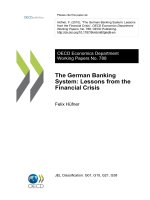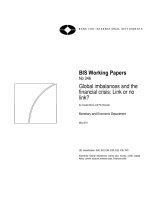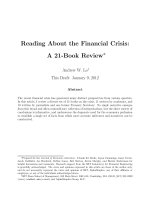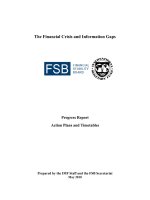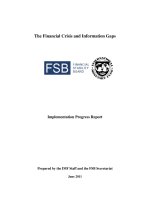The Financial Crisis Response In Charts potx
Bạn đang xem bản rút gọn của tài liệu. Xem và tải ngay bản đầy đủ của tài liệu tại đây (6.35 MB, 24 trang )
The Financial Crisis Response
In Charts
April 2012
Challenges
Reform
Introduction
U.S. DEPARTMENT OF THE TREASURY
Cost
Response
T
his week, the U.S. Department of the Treasury released its latest cost estimates for the Troubled Asset Relief Program
(TARP), which was only one part of the government’s broader effort to combat the nancial crisis. These charts
provide a more comprehensive update on the impact of the combined actions of the Treasury, the Federal Reserve, and
the Federal Deposit Insurance Corporation (FDIC).*
Collectively, these programs—carried out by both a Republican and a Democratic administration—were effective in
preventing the collapse of the nancial system, in restarting economic growth, and in restoring access to credit and
capital. They were well-designed and carefully managed. Because of this, we were able to limit the broader economic and
nancial damage. Although this crisis was caused by a shock larger than that which caused the Great Depression, we
were able to put out the nancial res at much lower cost and with much less overall economic damage than occurred
during a broad mix of nancial crises over the last few decades.
Our economy is stronger today because of the strategy we adopted and the nancial reforms now being put in place.
This, in turn, has allowed our nancial system to return as an engine for economic growth, jobs, and innovation. These
are the most important measures of the impact of the nancial strategy adopted by the United States.
In addition, the latest available estimates indicate that the nancial stability programs are likely to result in an overall
positive nancial return for taxpayers in terms of direct scal cost. These estimates are based on gains already realized and
on a range of different measures of cost and return for the remaining investments outstanding. These estimates do not
include the full impact of the crisis on our scal position. And they do not include the cost of the tax cuts and emergency
spending programs passed by Congress in the Recovery Act and after that were critically important to restarting economic
growth.
Although the economy is getting stronger, we have a long way to go to fully repair the damage the crisis has left
behind. We are still living with the broader economic cost of the crisis, which can be seen in high unemployment, the
moderate pace of recovery, scal decits still swollen by the crisis, the remaining constraints on access to credit, and the
remaining challenges in the housing market.
But the damage would have been far worse, and the costs far higher, without the government’s forceful response.
* This document focuses on many actions that made up the coordinated government response but is not meant to provide a complete inventory. In particular, while the Federal Reserve co-
ordinates with other government agencies on some actions, it acts independently with regard to monetary policy.
This recession was the worst since the Great Depression
U.S. DEPARTMENT OF THE TREASURY
Source: Bureau of Economic Analysis, Bureau of Labor Statistics, Federal Reserve Flow of Funds.
Real GDP, percent fall from pre-recession peak
-6%
-5%
-4%
-3%
-2%
-1%
0%
Pre-recession
peak
12
Years since pre-recession GDP peak
2007 - 09 recession
2001 recession
1990 - 91 recession
1981 - 82 recession
1980 recession
1974 recession
= trough
1
Metrics of the ‘07 - ’09 nancial crisis, peak-to-trough:
8.8 million
jobs lost
$19.2 trillion
lost household wealth
(2011 dollars)
Challenges
Reform
Cost
Response
2007 2008 2009 2010 2011
+0.5%
+3.6%
+3.0%
+1.7%
-1.8%
+1.3%
-3.7%
-8.9%
-6.7%
-0.7%
+1.7%
+3.8%
+3.9%
+3.8%
+2.5%
+2.3%
+0.4%
+1.3%
+1.8%
+3.0%
Challenges
Reform
The crisis response helped restart economic growth
U.S. DEPARTMENT OF THE TREASURY
Source: Bureau of Economic Analysis.
2
Real GDP growth, quarterly
Jan. 20, 2009
President Obama
takes ofce
Feb. 2009
Financial Stability Plan announced
Recovery Act signed
Housing programs announced
Mar. 3, 2009
TALF program launched to help
revive credit markets
Mar. 23, 2009
PPIP program announced to help
revive mortgage nance market
May 7, 2009
Large bank stress test results released
Apr. 2, 2009
G-20 nance ministers announce
coordinated response to global
nancial crisis
Jun. 2009
First large banks repay TARP funds
GM restructuring
Oct. 3, 2008
TARP nancial stabilization
package enacted
Cost
Response
Mar. 2008
Bear Stearns collapses
Sept. 2008
Fannie Mae and Freddie Mac conservatorship
Lehman Brothers bankruptcy
AIG stabilization effort
Jul. 7, 2008
FDIC intervenes
in IndyMac Bank
Dec. 12, 2007
Fed establishes rst liquidity
facility and currency swap lines
with other central banks
2007 2008 2009 2010 2011
-
2,000
4,000
6,000
8,000
10,000
12,000
14,000
16,000
-
200
400
600
800
1,000
1,200
1,400
1,600
3
The crisis response paved the way for retirement savings to recover
U.S. DEPARTMENT OF THE TREASURY
Source: Federal Reserve Flow of Funds.
S&P 500 index
Retirement fund assets
(billions of 2011 dollars)
Jan. 20, 2009
President Obama
takes ofce
Feb. 2009
Financial Stability Plan announced
Recovery Act signed
Housing programs announced
Mar. 3, 2009
TALF program launched to help revive credit markets
Mar. 23, 2009
PPIP program announced to help revive
mortgage nance markets
May 7, 2009
Large bank stress test results released
Apr. 2, 2009
G-20 nance ministers announce
coordinated response to global
nancial crisis
Oct. 3, 2008
TARP nancial stabilization package passed
Jun. 2009
First large banks repay TARP funds
GM restructuring
Mar. 2008
Bear Stearns
collapses
Sept. 2008
Fannie Mae/Freddie Mac conservatorship
Lehman Brothers bankruptcy
AIG stabilization effort
Challenges
Reform
Cost
Response
2006 2007 2008 2009 2010 2011
More More
banksbanks
tighteningtightening
The crisis response helped unclog the credit pipes of the nancial system
U.S. DEPARTMENT OF THE TREASURY
Source: Federal Reserve Senior Loan Ofcer Opinion Survey, Treasury calculations.
The crisis response helped
restart the markets that
provide nancing for auto,
credit card, mortgage, and
business loans.
For borrowers, it:
• Improved credit access
• Lowered borrowing
costs.
4
Net percentage of banks easing lending standards, by loan type
More More
banks banks
easingeasing
-100
-80
-60
-40
-20
0
20
40
Commercial and industrial lending
Residential mortgages
Consumer credit cards
Jan. 20, 2009
President Obama
takes ofce
Feb. 2009
Financial Stability Plan announced
Recovery Act passed
Housing programs announced
Mar. 3, 2009
TALF program launched
Mar. 23, 2009
PPIP program announced to help
revive mortgage nance markets
May 7, 2009
Large bank stress test
results released
Oct. 3, 2008
TARP enacted
Jun. 2009
First large banks repay TARP funds
Challenges
Reform
Cost
Response
99%
99%
100%
Credit cards
Auto loans
Agency
mortgages
How much has the price of credit
recovered since the crisis?
As measured by the return of yields of asset-
backed securities to their pre-crisis levels
Financial
markets
Small
businesses
Autos
Housing
Retirement
Consumers
Helped support
companies that
need credit to hire
and grow.
Helped support a
crucial
manufacturing
industry and save
American jobs.
Helped restart
credit markets and
stabilize firms that
hold deposits and
provide credit.
Helped support
families that need
auto, credit card,
and student loans.
Helped protect
savers with 401(k)
plans, money
market funds, and
other investments.
Helped support
Americans seeking
to obtain or
refinance a
mortgage, or
avoid foreclosure.
Small business
Autos
Financial markets
Consumers
Retirement
Housing
What did it support?
The crisis response helped support families and businesses
U.S. DEPARTMENT OF THE TREASURY
Source: Treasury, Ofce of Management and Budget.
5
Challenges
Reform
Cost
Response
The Treasury Department, the Federal Reserve, and other federal agencies attacked the crisis on multiple fronts so that families could meet
their nancial needs and businesses could obtain the credit they need to hire and grow.
This chart is intended to illustrate the breadth of the crisis response, but is not meant to be a complete depiction of all the actions taken by the government or their effects.
The crisis response helped stabilize the housing market
U.S. DEPARTMENT OF THE TREASURY
Source: Federal Reserve, HOPE NOW, Department of Housing and Urban Development.
6
Conventional 30-year mortgage rates
The government’s
efforts helped keep
mortgage rates low so
that Americans could
continue to buy homes
and renance in the wake
of the crisis.
Since April 2009, loan
modication programs
have helped millions of
borrowers stay in their
homes, more than the
number who have lost
their homes to foreclosure.
Cumulative foreclosures and permanent modications started*
Challenges
Reform
Cost
Response
* Cumulative HAMP permanent modications, FHA loss mitigation (such as modications, partial claims, and forbearance plans), and early delinquency interventions, plus proprietary modications completed as reported by the HOPE
NOW Alliance. Some homeowners may be counted in more than one category. Foreclosure completions are properties entering Real Estate Owned (REO) as reported by Realty Trac. This does not include other loss mitigation actions taken
under Treasury housing programs or by the GSEs, such as forbearance plans, short sales, and second lien modications, which would increase the totals.
0
1
2
3
4
5
6
Apr '09 Jul '09 Oct '09 Jan '10 Apr '10 Jul '10 Oct '10 Jan '11 Apr '11 Jul '11 Oct '11 Jan '12
Private
modifications
Since April 2009, there have been
5 million permanent loan modifications
Foreclosure
completions
2.6m
HAMP modifications
FHA loss mitigation
6 million
0
1
2
3
4
5
6
7
Jan '08 Jul '08 Jan '09 Jul '09 Jan '10 Jul '10 Jan '11 Jul '11 Jan '12
7 percent
2.2
2.3
2.4
2.5
Jan
2009
'10 '11 '12
2.6m auto industry workers
+231,000
auto jobs since
June 2009
The crisis response saved the auto industry and one million American jobs
U.S. DEPARTMENT OF THE TREASURY
Source: Bureau of Labor Statistics, Autodata.
According to
independent estimates,
the rescue of the auto
industry saved more than
one million American jobs.
Since the rescue, the
auto industry has added
more than 230,000 jobs.
The auto industry
rescue is currently
estimated to cost about
$22 billion, but the cost
of a disorderly liquidation
to families and businesses
across the country that
rely on the auto industry
would have been far
higher.
7
Auto-industry employment
After June 2009
Post-restructuring of
GM and Chrysler
Mar. 2009
President Obama rejects restructuring plans from
GM and Chrysler, challenging them to develop
more aggressive plans to return to viability.
Sales of motor vehicles in the U.S.
13m
10m
12m
13m
14.5m
2008 2009 2010 2011 2012
(annualized
average to
date)
Challenges
Reform
Cost
Response
The crisis response curbed the damage and helped restart the economy
U.S. DEPARTMENT OF THE TREASURY
Source: Treasury analysis based on OECD and U.S. Census data.
8
Total civilian employment, percentage change from pre-crisis peak
Jobs are returning.
Despite the size of the
nancial shock, the
speed and force of the
response helped restore
job growth more quickly
than in most other
recent crises.
There is still more
work ahead, but
businesses have
• Added workers over
the last 25 straight
months.
• Created 4.1 million
jobs.
U.S.
Great Depression
-30%
-20%
-10%
0%
+10%
+20%
Pre-
crisis
peak
1 2 3 4 5 6 7 8 9 10 11 12 13 14 15 16 17 18 19 20
Years since pre-crisis employment peak
U.S.
2008-09
financial crisis
Average of 5 most recent
advanced economy financial crises
Spain 1974
Norway 1986
Finland 1989
Sweden 1989
Japan 1991
Jobs growth resumed much faster
than average of other recent nancial
crises in advanced economies
Challenges
Reform
Cost
Response
IMF March 2009 estimate of the cost
of U.S. response to ‘08-’09 crisis
12.7%
of GDP
($1.9
trillion in 2011$)
Estimated total potential exposure
from financial rescue
$24 trillion
Special Inspector General for TARP, July 2009
U.S. pledges top
$7.7
trillion
to ease frozen credit
Bloomberg
November 24, 2008
“
How much were the nancial stability programs expected to cost?
U.S. DEPARTMENT OF THE TREASURY
Source: See Notes.
9
Projections of potential cost of nancial stability programs
Bank bailout could cost
$4 trillion
CNNMoney.com
January 27, 2009
“
Fannie, Freddie bailout
could cost taxpayers
$1
trillion
The Christian Science Monitor
June 18, 2010
“
Estimated cost of TARP
$356 billion
Congressional Budget Office, March 2009
Estimated cost of TARP
$341
billion
Office of Management and Budget, August 2009
Challenges
Reform
Cost
Response
+$1b
Treasury money
market fund
guarantee program
TARP housing
programs
-$16b
CBO estimate
Other
Treasury
-$46b
OMB estimate
+$2b
+$25b
Treasury Mortgage-
Backed Securities
Purchase Program
Treasury TARP
investment programs
and additional
AIG holdings
-$151b
Current net cost
+$179b
Federal
Reserve
excess
earnings**
-$28b
OMB projection of net
cost through FY2022
Fannie Mae/
Freddie Mac
conservatorship*
In fact, taxpayers may realize a gain
Source: Treasury, Ofce of Management and Budget. See Notes for further details on calculations.
10
* Treasury currently has a net investment of $151b in Fannie Mae and Freddie Mac, which is expected to be reduced over time as those rms generate positive earnings. OMB projects
the eventual cost to fall to $28b by scal year 2022. This estimate however could change materially depending on future changes in home prices, enterprise market share, and other
operating assumptions.
** Treasury estimates. Based on the President’s FY2013 Budget, the Federal Reserve has already remitted $82 billion in excess earnings – above what would be expected in normal
times – to the Treasury through scal year 2011. Total excess earnings from the Federal Reserve to be remitted to the general fund are currently forecast to reach $179 billion through
scal year 2015. The amount of future Federal Reserve earnings is uncertain and will depend on future nancial, economic, and market conditions.
Note: Estimates are most recently available as of publication and are subject to revision based on future market conditions. Chart includes income and costs for the nancial stability
programs only. It does not include gures related to the Recovery Act or tax revenues lost from the crisis.
Overall, the government is now
expected to at least break even
on its nancial stability programs
and may realize a positive return.
Treasury’s TARP investments and
overall stake in AIG, purchase of
mortgage-backed securities, and
Money Market Fund guarantee
program are each currently expected to
realize an overall positive return for
taxpayers. Additionally, the Federal
Reserve is remitting signicant excess
earnings to the Treasury.
There are a range of estimates on the
ultimate cost of TARP’s foreclosure
prevention programs and stabilizing
Fannie Mae and Freddie Mac, which
will depend upon future housing
market conditions and other factors.
However, the overall positive returns
from the other nancial stability
programs are currently expected to
more than offset those costs,
according to the latest estimates.
Projections of nancial stability program returns/costs, based on latest estimates
U.S. DEPARTMENT OF THE TREASURY
Challenges
Reform
Cost
Response
The projected cost of TARP has fallen signicantly
U.S. DEPARTMENT OF THE TREASURY
Source: Treasury, Ofce of Management and Budget.
The projected cost of
TARP has fallen signicantly
over the last three years.
TARP’s investment
programs, together with
Treasury’s additional stake in
AIG, are currently expected
to realize a positive return
for taxpayers.
The remaining
projected cost is primarily
attributable to support for
struggling homeowners;
these funds were not
intended to be recovered.
TARP programs have
received three straight clean
audits.**
11
Projections of TARP programs and additional Treasury AIG holdings, gain (cost)
-$341b
-$60b
-$291b
+$2b
-400
-350
-300
-250
-200
-150
-100
-50
0
50
Aug. 2009
Mid-session Review
Feb. 2010
President's Budget
Feb. 2011
President's Budget
Feb. 2012
President's Budget
Apr. 2012
estimate
+$50 billion
-$400 billion loss
TARP
overall
Investment programs only
(excludes housing)*
83%
decrease in projected
TARP costs since
Aug. '09
POSITIVE RETURN
LOSS
Challenges
Reform
Cost
Response
* This represents the TARP investment programs and includes Treasury’s additional AIG common stock holdings valued as of February
29, 2012. It excludes foreclosure prevention funds, which were not intended to be recovered ($46B).
** GAO annually reviews Treasury TARP cost estimates.
The bank investment program helped stabilize the nancial system
Source: Treasury.
TARP’s bank
investment programs
helped stabilize the
nancial system by
providing capital to more
than 700 banks
throughout the country.
More than 450 were
small, community banks.
Treasury is continuing
to wind down those
investments, which have
already realized a
signicant return for
taxpayers.
12
Returns as of April 12, 2012
Federal Reserve regulatory minimum on stress tests
-
50
100
150
200
250
300
Oct
'08
Apr
'09
Oct
'09
Apr
'10
Oct
'10
Apr
'11
Oct
'11
Apr
'12
$300 billion
$245b
Repayments
$230b
Realized
income
$34b
Disbursed Recovered
$264b
Outstanding bank program investments, principal
+$19b
positive
return
Note: About $2b of the funds invested in banks renanced into the SBLF program. This
reects less than 1% of the total TARP funds invested in banks.
A total of 348 banks remain in TARP’s Capital Purchase Program and 82
banks remain in TARP’s Community Development Capital Initiative
U.S. DEPARTMENT OF THE TREASURY
Challenges
Reform
Cost
Response
Max. commitment
March 2009
Remaining Investment Outstanding Value of Remaining Stake
76%
of maximum committment
returned or cancelled to date
$44b
$182b
Current Value of
Remaining
Government Stake
$49b
Interest/ Fees/Gains
Realized to Date
$12b
$61b
Based on current market
prices, the government is
expected to realize a gain on
its AIG investment
Remaining investment outstanding
As of March 2012
Value of remaining stake
As of March 2012
The crisis response helped prevent the collapse of the nancial system and stabilized AIG
U.S. DEPARTMENT OF THE TREASURY
Source: Treasury, Federal Reserve.
13
Total commitment (Treasury and Federal Reserve), outstanding investment, and value of ownership stake in AIG,
billions of dollars
Challenges
Reform
Cost
Response
The nancial industry is less vulnerable to shocks than before the crisis
U.S. DEPARTMENT OF THE TREASURY
Source: Federal Reserve form Y-9C, Treasury calculations.
Banks have added
nearly $400 billion in
fresh capital as a
cushion against
unexpected losses and
nancial shocks.
Banks are also less
reliant on short-term
funding, which can
disappear in a crisis and
leave them more
vulnerable to panics.
14
Federal Reserve regulatory minimum on stress tests
Short-term wholesale funding as a percent
of assets, 4 largest U.S. banks
0
5
10
15
20
25
30
35
40
2002
Q1
'03 '04 '05 '06 '07 '08 '09 '10 '11
40 percent
0
2
4
6
8
10
12
14
2002
Q1
'03 '04 '05 '06 '07 '08 '09 '10 '11
Other Tier 1
Tier 1 Common
14 percent
Capital in bank holding companies as a
percentage of risk-weighted assets
Challenges
Reform
Cost
Response
The U.S. banking system is proportionally smaller than that of other advanced economies
U.S. DEPARTMENT OF THE TREASURY
Source: BankScope, IMF, Federal Reserve Flow of Funds.
15
Total assets of commercial banks, percent of GDP
Total assets of 4 largest commercial banks, percent of GDP
Even with the
consolidation of some of
the weakest players during
the crisis, the United
States has
• the least concentrated
banking system of any
major economy.
• the smallest banking
system relative to the
size of its economy.
The new legal tools
established by the Dodd-
Frank Act mean that
regulators will be better
able to dismantle and
resolve large nancial
institutions if necessary.
Belgium
Canada
France
Germany
Italy
Japan
Netherlands
Sweden
Switzerland
United Kingdom
United States
0%
100%
200%
300%
400%
500%
600%
0% 100% 200% 300% 400% 500% 600%
Challenges
Reform
Cost
Response
The economy still has far to go to fully recover from the nancial crisis
U.S. DEPARTMENT OF THE TREASURY
Source: Bureau of Labor Statistics, Congressional Budget Ofce.
Unemployment rate, percent of the labor force
Real output gap
Unemployment
has fallen, but it still
remains high.
Economic output
remains well below
its potential.
16
Long-term
unemployment
rate
(27+ weeks)
0
2
4
6
8
10
12
Jan
2006
'07 '08 '09 '10 '11 '12
12 percent
Unemployment
rate
Recessions
10
11
12
13
14
15
'00 '01 '02 '03 '04 '05 '06 '07 '08 '09 '10 '11
5.5%
output gap
in 2011Q4
$15 trillion
Real GDP
(2005 dollars)
Real potential GDP
(2005 dollars)
Recessions
Challenges
Reform
Cost
Response
The longstanding nancial difculties facing households persist
U.S. DEPARTMENT OF THE TREASURY
Source: Federal Reserve Flow of Funds, U.S. Census.
Household debt, percent of disposable income
Household debt is
down relative to income,
but a large overhang of
debt remains.
Median household
income has declined
over the last decade.
17
Real median household income
0
20
40
60
80
100
120
140
160
1980
Q1
'85 '90 '95 '00 '05 '10
160 percent
Recessions
40,000
45,000
50,000
55,000
60,000
1967 '72 '77 '82 '87 '92 '97 '02 '07
1999: $53,252
$ 60,000
2010: $49,445
Recessions
Challenges
Reform
Cost
Response
The housing market remains a challenge
U.S. DEPARTMENT OF THE TREASURY
Source: U.S. Census.
Inventory of vacant homes for sale only
New single-family home sales
Inventories of
unsold homes are
declining, but slowly.
The overhang from the
crisis continues to
weigh on prices.
New home sales
are stabilizing, but the
housing market
remains weak.
18
0
0.4
0.8
1.2
1.6
Jan
2003
'04 '05 '06 '07 '08 '09 '10 '11 '12
1.4 million Jul. 2005
313,000 Feb. 2012
1.6 million
Recessions
0
0.5
1.0
1.5
2.0
2.5
2004
Q1
'05 '06 '07 '08 '09 '10 '11
2.5 million
Recessions
Challenges
Reform
Cost
Response
Tax Cuts
-$3,000b
Other annual
appropriations
-$1,700b
Iraq and
Afghanistan
-$1,400b
Other
-$600b
Medicare
Part D benefit
-$300b
December 2010
tax deal
-$250b
Recovery Act
-$800b
Other
-$410b
The federal budget decit must be reduced to begin paying down debt
U.S. DEPARTMENT OF THE TREASURY
Source: Treasury analysis of Congressional Budget Ofce data. See Notes for more details.
19
-8
-6
-4
-2
0
2
4
6
8
2001 '02 '03 '04 '05 '06 '07 '08 '09 '10 '11
$8 trillion
COSTS NOT DUE
TO LEGISLATION
(technical &
economic)
Cost of
January 2001 -
January 2009
policies
Cost of post-
January 2009
policies
29%
59%
12%
In January 2001, CBO projected
cumulative surpluses would
total $5.9 trillion through 2011.
CUMULATIVE
SURPLUS
CUMULATIVE
DEFICIT
Instead, cumulative deficits
have totaled $6.0 trillion.
Post-January 2009
Policies
-$1.4 trillion
through 2011
Jan. 2001 - Jan. 2009
Policies
-$7 trillion
through 2011
Challenges
Reform
Cost
Response
Causes of the difference between projected and actual cumulative budget surpluses/decits, scal years 2001 - 2011
Notes
U.S. DEPARTMENT OF THE TREASURY
N
Chart 1
“Household wealth” measured as net worth of
households in the Flow of Funds. Adjusted to 2011
dollars using the personal consumption expenditures
chain price index.
Chart 3
“Retirement fund assets” measured as pension fund
reserves held as assets by households in the Flow of
Funds. Adjusted to 2011 dollars using the personal
consumption expenditures chain price index.
Chart 4
Mortgage price of credit measured by spread between
jumbo and conventional mortgages.
Credit cards measured by the 3 year spread-to-swap
of xed AAA.
Autos measured by the 3 year spread-to-swap of
prime xed AAA.
Chart 7
“Auto industry employment” includes all payrolls in
retail motor vehicle and parts dealers, both in the
manufacturing and service sectors.
White House, “The Resurgence of the American
Automotive Industry”, June 2011. Available at http://
www.whitehouse.gov/sites/default/les/uploads/
auto_report_06_01_11.pdf
Center for Automotive Research, “The Impact on the
U.S. Economy of the Successful Automaker
Bankruptcies,” 17 November 2010. Available at
Chart 8
“Average of 5 most recent advanced economy
nancial crises” includes Spain (indexed to 1974Q2),
Norway (1986Q4), Finland (1989Q3), Sweden
(1989Q4), and Japan (1991Q1). Advanced country
nancial crises selected based on Reinhart & Rogoff
2009 and indexed to pre-crisis civilian employment
peak based on OECD Outlook data. U.S. employment
data for the Great Depression series comes from the
U.S. Census’
Historical Statistics of the United States:
Colonial Times to 1970
, Table A-3.
Chart 9
CNN Money, />bigger.bailout.fortune/
International Monetary Fund, The State of Public
Finances: Outlook and Medium-Term Policies After the
2008 Crisis, at p17, available at />external/np/pp/eng/2009/030609a.pdf
Special Inspector General for TARP, Quarterly Report
to Congress, July 21, 2009, />reports/congress/2009/
July2009_Quarterly_Report_to_Congress.pdf
Christian Science Monitor, />Business/new-economy/2010/0618/Fannie-Freddie-
bailout-could-cost-taxpayers-1-trillion
Bloomberg, />sid=an3k2rZMNgDw&pid=newsarchive
Congressional Budget Ofce, “A Preliminary Analysis
of the President’s Budget and an Update of CBO’s
Budget and Economic Outlook”, Mar. 2009, p8.
Available at
/>PresidentBudget.pdf
Government Accountability Ofce,
Financial Audit:
Resolution Trust Corporation’s 1994 and 1995
Financial Statements
, 1996, p13. Available at http://
www.gao.gov/archive/1996/ai96123.pdf.
Ofce of Management and Budget,
President’s
FY2013 Budget
, “Analytical Perspectives”, p39.
Available at />les/omb/budget/fy2013/assets/spec.pdf
Chart 10
Data reect latest available estimates in each
category. “Gain” or “positive return” dened as cash
received (whether as principal, interest, dividends, or
other) exceeds cash disbursed, regardless of the timing
of collection.
TARP housing program gures reect estimates as
of February 2012. Ofce of Management Budget
projections assume that the $46 billion in funds
committed through TARP’s foreclosure prevention
programs to help struggling homeowners will be
spent. Congressional Budget Ofce projections reect
Challenges
Reform
Cost
Response
Notes
U.S. DEPARTMENT OF THE TREASURY
N
a cost of $16 billion for these programs. TARP housing
program funds are not intended to be recovered.
/>attachments/03-28-2012TARP.pdf
TARP investment programs and additional
Treasury holdings in AIG reect market values and
realized gains as of February 29, 2012. The estimated
lifetime return of $22 billion on TARP’s bank
investment programs and more than $2 billion return
on TARP’s credit market programs are expected to
more than offset the $22 billion expected cost of the
auto industry rescue. Treasury’s investment in AIG
(which includes both TARP and non-TARP shares) is
expected to at least break even at current market
prices. See the latest 105(a) report for further details
on TARP cost estimates: />initiatives/nancial-stability/brieng-room/reports/105/
Documents105/March%2012%20Report%20to%
20Congress.pdf
Treasury money market fund guarantee
purchase program reects realized gains as of the
close of the program in September 2009. Treasury
incurred no losses under this program and earned
approximately $1.2 billion in participation fees.
Treasury mortgage-backed security program
reect realized returns as of the close of the wind
down of the program in March 2012. Those positive
returns totaled $25 billion. Overall, Treasury invested
$225 billion in MBS and recovered $250 billion
through principal and interest payments, and sales.
The ultimate cost of Fannie Mae and Freddie Mac
conservatorship, which was necessary to keep
mortgage credit available in the wake of the crisis, will
depend on housing market conditions over time as
well as how the agencies are wound down. The $28
billion amount is the net cost to Treasury through
2022 as projected by the Ofce of Management and
Budget for the purposes of the President’s FY2013
Budget. The current net cost is $151 billion. Fannie
Mae and Freddie Mac’s losses are primarily the result
of loans written before the crisis. OMB’s estimate
assumes that Fannie Mae and Freddie Mac will
generate positive earnings from the run off of their
more conservative post-crisis book of business to help
pay back taxpayers.
Treasury’s estimate of Federal Reserve excess
earnings is based on calculations from the
President’s FY2013 Budget, released in February
2012. The Federal Reserve has already remitted $82
billion in excess earnings – above what would be
expected in normal times – to the Treasury through
scal year 2011. Total excess earnings from the
Federal Reserve expected to be remitted to the general
fund are currently forecast to reach $179 billion
through scal year 2015. The amount of future
Federal Reserve earnings is uncertain and will depend
on future nancial and economic conditions.
Methodology:
Treasury estimates reect “excess”
earnings from the Federal Reserve applied to the
federal budget. Excess earnings reect earnings on
loans and asset purchases made by the Federal
Reserve through extraordinary programs established to
mitigate the nancial crisis. Treasury assumes earnings
will converge to normalized levels by scal year 2015.
The Federal Reserve generates signicant income on
its assets during “normal” times, the majority of
which it remits to Treasury. For example, in 2006,
prior to the nancial crisis, the Federal Reserve
remitted $30 billion of such earnings. To estimate
excess earnings, Treasury calculates a normalized path
of earnings from 2006 through 2015. Treasury
assumes earnings would have increased at a uniform
rate from 2006 to the level projected by the
President’s FY2013 Budget for scal year 2015. The
amount of future Federal Reserve earnings is uncertain
and will depend on future nancial and economic
conditions.
The FDIC currently expects that fees paid by
participating institutions will cover any losses
associated with its bank debt insurance program put
in place during the crisis, known as the Temporary
Liquidity Guarantee Program (TLGP). Any excess
proceeds from TLGP are remitted to the FDIC’s Deposit
Insurance Fund (DIF). The DIF, which helps protect
savers, is funded through assessments on insured
depository institutions. The FDIC has not drawn upon
its Treasury line of credit for the DIF.
Chart 11
See the latest 105(a) report for further details on TARP
cost estimates: />Challenges
Reform
Cost
Response
Notes
U.S. DEPARTMENT OF THE TREASURY
N
nancial-stability/brieng-room/reports/105/
Documents105/March%2012%20Report%20to%
20Congress.pdf
Chart 13
See the latest 105(a) report for further details on TARP
cost estimates: />nancial-stability/brieng-room/reports/105/
Documents105/March%2012%20Report%20to%
20Congress.pdf
Chart 15
Four largest U.S. banks by assets are JPMorgan Chase,
Bank of America, Citigroup, and Wells Fargo.
Chart 19
Based on data from three annual Congressional
Budget Ofce publications: the
Budget and Economic
Outlook,
the update to the
Outlook
, and CBO’s
estimate of the President’s Budget. “Technical and
economic” factors include all changes in decit
projections not due to the cost of new legislation,
including updates to economic and demographic
projections. “Post-January 2009 policies” only reects
the effect of policies, including temporary policies,
through 2011. Does not reect the decit reduction
proposed in the President’s FY2013 Budget going
forward. Numbers may not sum due to rounding.
Challenges
Reform
Cost
Response
